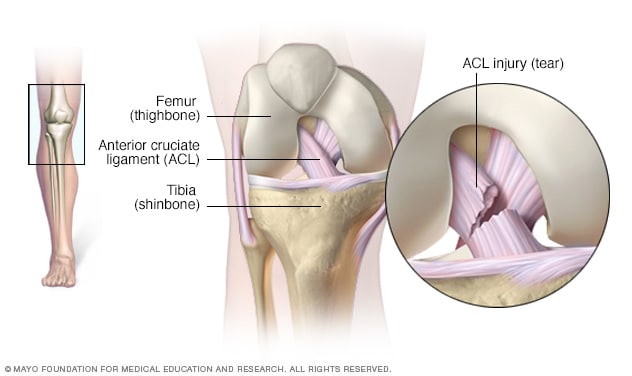Overview
ACL injury

ACL injury
The anterior cruciate ligament (ACL) is one of the key ligaments that help stabilize the knee joint. The ACL connects the thighbone (femur) to the shinbone (tibia). It's most commonly torn during sports that involve sudden stops and changes in direction — such as basketball, soccer, tennis and volleyball.
An ACL injury is a tear or sprain of the anterior cruciate (KROO-she-ate) ligament (ACL) — one of the strong bands of tissue that help connect your thigh bone (femur) to your shinbone (tibia). ACL injuries most commonly occur during sports that involve sudden stops or changes in direction, jumping and landing — such as soccer, basketball, football and downhill skiing.
Many people hear a pop or feel a "popping" sensation in the knee when an ACL injury occurs. Your knee may swell, feel unstable and become too painful to bear weight.
Depending on the severity of your ACL injury, treatment may include rest and rehabilitation exercises to help you regain strength and stability, or surgery to replace the torn ligament followed by rehabilitation. A proper training program may help reduce the risk of an ACL injury.
Products & Services
Symptoms
Signs and symptoms of an ACL injury usually include:
- A loud pop or a "popping" sensation in the knee
- Severe pain and inability to continue activity
- Rapid swelling
- Loss of range of motion
- A feeling of instability or "giving way" with weight bearing
When to see a doctor
Seek immediate care if any injury to your knee causes signs or symptoms of an ACL injury. The knee joint is a complex structure of bones, ligaments, tendons and other tissues that work together. It's important to get a prompt and accurate diagnosis to determine the severity of the injury and get proper treatment.
Causes
Ligaments are strong bands of tissue that connect one bone to another. The ACL, one of two ligaments that cross in the middle of the knee, connects your thighbone to your shinbone and helps stabilize your knee joint.
ACL injuries often happen during sports and fitness activities that can put stress on the knee:
- Suddenly slowing down and changing direction (cutting)
- Pivoting with your foot firmly planted
- Landing awkwardly from a jump
- Stopping suddenly
- Receiving a direct blow to the knee or having a collision, such as a football tackle
When the ligament is damaged, there is usually a partial or complete tear of the tissue. A mild injury may stretch the ligament but leave it intact.
Risk factors
There are a number of factors that increase your risk of an ACL injury, including:
- Being female — possibly due to differences in anatomy, muscle strength and hormonal influences
- Participating in certain sports, such as soccer, football, basketball, gymnastics and downhill skiing
- Poor conditioning
- Using faulty movement patterns, such as moving the knees inward during a squat
- Wearing footwear that doesn't fit properly
- Using poorly maintained sports equipment, such as ski bindings that aren't adjusted properly
- Playing on artificial turf
Complications
People who experience an ACL injury have a higher risk of developing osteoarthritis in the knee. Arthritis may occur even if you have surgery to reconstruct the ligament.
Multiple factors likely influence the risk of arthritis, such as the severity of the original injury, the presence of related injuries in the knee joint or the level of activity after treatment.
Prevention
Proper training and exercise can help reduce the risk of ACL injury. A sports medicine physician, physical therapist, athletic trainer or other specialist in sports medicine can provide assessment, instruction and feedback that can help you reduce risks.
Programs to reduce ACL injury include:
- Exercises to strengthen the core — including the hips, pelvis and lower abdomen — with a goal of training athletes to avoid moving the knee inward during a squat
- Exercises that strengthen leg muscles, particularly hamstring exercises, to ensure an overall balance in leg muscle strength
- Training and exercise emphasizing proper technique and knee position when jumping and landing from jumps
- Training to improve technique when performing pivoting and cutting movements
Training to strengthen muscles of the legs, hips and core — as well as training to improve jumping and landing techniques and to prevent inward movement of the knee — may help to reduce the higher ACL injury risk in female athletes.
Gear
Wear footwear and padding that is appropriate for your sport to help prevent injury. If you downhill ski, make sure your ski bindings are adjusted correctly by a trained professional so that your skis will release appropriately if you fall.
Wearing a knee brace doesn't appear to prevent ACL injury or reduce the risk of recurring injury after surgery.
The Mayo Clinic experience and patient stories
Our patients tell us that the quality of their interactions, our attention to detail and the efficiency of their visits mean health care like they've never experienced. See the stories of satisfied Mayo Clinic patients.
Dec. 01, 2022